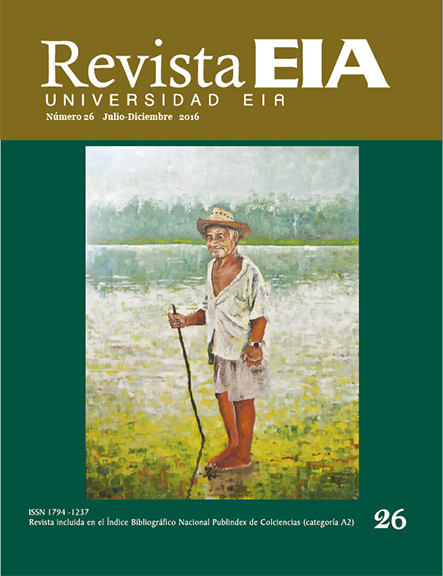ASIGNACIÓN DE FRECUENCIAS ÓPTIMAS, A TRAVÉS DE UN MODELO MULTIOBJETIVO, PARA UN SISTEMA BRT
ASIGNACIÓN DE FRECUENCIAS ÓPTIMAS, A TRAVÉS DE UN MODELO MULTIOBJETIVO, PARA UN SISTEMA BRT

Copyright statement
The authors exclusively assign to the Universidad EIA, with the power to assign to third parties, all the exploitation rights that derive from the works that are accepted for publication in the Revista EIA, as well as in any product derived from it and, in in particular, those of reproduction, distribution, public communication (including interactive making available) and transformation (including adaptation, modification and, where appropriate, translation), for all types of exploitation (by way of example and not limitation : in paper, electronic, online, computer or audiovisual format, as well as in any other format, even for promotional or advertising purposes and / or for the production of derivative products), for a worldwide territorial scope and for the entire duration of the rights provided for in the current published text of the Intellectual Property Law. This assignment will be made by the authors without the right to any type of remuneration or compensation.
Consequently, the author may not publish or disseminate the works that are selected for publication in the Revista EIA, neither totally nor partially, nor authorize their publication to third parties, without the prior express authorization, requested and granted in writing, from the Univeridad EIA.
Show authors biography
En este artículo se aborda el problema de optimización de frecuencias en un Sistema Integrado de Transporte Público (SITP). La metodología aplicada se centró en encontrar la frecuencia óptima de despacho de buses en diferentes rutas. El modelo planteado se aplicó a una reducción del SITP en la ciudad de Pereira (Risaralda, Colombia), el cual es del tipo Bus Rapid Transit (BRT).
La frecuencia óptima se determina de acuerdo a la demanda de viajes estimada, la capacidad de los buses, y el tamaño de la flota disponible. Se propone una función multiobjetivo que minimiza el tiempo de parada en las estaciones, los costos económicos de las empresas operadoras y una penalización adicional que se da cuando un usuario debe esperar por un segundo bus. Finalmente se propone una metodología para escoger los ponderadores de la función objetivo
El modelo fue resuelto mediante un Algoritmo Genético (AG). Las frecuencias de despacho fueron acotadas, logrando una disminución del espacio de soluciones, obteniéndose como respuesta intervalos de despacho operables. El modelo fue probado en diferentes escenarios con una demanda baja, media y alta, con el fin de evidenciar los cambios en la calidad del servicio, y establecer una política de despacho adecuada.Article visits 875 | PDF visits 476
Downloads
- Baaj, M. Mahmassani, H. (1991). “An AI-based approach for transit route system planning and design”. Journal of Advanced Transportation, 25(2):187–210.
- Ceder, A. Public Transit Planning and Operation. UK. Elsevier. 2007. 4 – 8
- Disponible en:
- http://www.chinautc.com/information/manage/UNCC_Editor/uploadfile/20091110111131356.pdf
- Cervero, R. (2013). “Bus Rapid Transit (BRT): An Efficient and Competitive Mode of Public Transport”. Reporte para: European Automobile Manufacturers Association. Working Paper 2013-01.
- Disponible en: http://iurd.berkeley.edu/wp/2013-01.pdf
- Cepeda, M. Cominetti, R. Florian, M. (2006). “A frequency based assignment model for congested transit networks with strict capacity constraints: characterization and computation of equilibria.” Transportation Research Part B 40, 437–459
- Disponible en: http://www.sciencedirect.com/science/article/pii/S0191261505000743
- Cortés, C. Jara, P. Moreno, E. (2012). “Stochastic Transit Equilibrium”. Transportation Research Part B 51. 29–44
- Disponible en: http://www.sciencedirect.com/science/article/pii/S0191261513000210#
- Fan, W. Machemehl, R. (2004). “A Tabu Search based heuristic method for the transit route network design problem.” Computer Aided Scheduling of Public Transport. Part IV. 387–408
- Disponible en: http://link.springer.com/chapter/10.1007%2F978-3-540-73312-6_20
- Fernández, J. Cea, J. Malbran, H. (2008). “Demand responsive urban public transport system design: methodology and application.” Transportation Research Part A 42 (7), 951–972.
- Disponible en: http://www.sciencedirect.com/science/article/pii/S0965856408000281
- Holland, J. Adaptation in Natural and Artificial Systems: An Introductory Analysis with Applications to Biology, Control and Artificial Intelligence. Estados Unidos. Mit University Press Group Ltd. 1992.
- Huang, Z. Ren, G. y Liu, H. (2013). “Optimizing Bus Frequencies under Uncertain Demand: Case Study of the Transit Network in a Developing City”. Hindawi Publishing Corporation. Nanjing 210096. 1–10
- Disponible en: http://www.hindawi.com/journals/mpe/2013/375084/
- Kov, M. Fukuda, D. Yai T. (2011). “Optimizing Frequency of Bus Service in Mixed-Traffic Urban Street.” Asian Transport Studies. Volume 1, Issue 4, 352 – 367
- Disponible en:
- http://www.academia.edu/1556133/Optimizing_frequency_of_bus_service_in_mixed-traffic_urban_street
- Lam, W.H.K., Cheung, C.Y., Poon, Y.F., 1998. “A study of train dwelling time at the Hong Kong Mass Transit Railway system.” Journal of Advanced Transportation 32, 285–296.
- Liebchen C. Peeters L. (2009). “Integral cycle bases for cyclic timetabling.” Discrete Optimization. 6. 98–109
- Disponible en: http://www.sciencedirect.com/science/article/pii/S1572528608000674
- Martínez, H. Mauttone, A. Urquhart, M (2013). “Formulación y meta heurística para el problema de la determinación de frecuencias en el transporte colectivo público”. Congreso Latino Iberoamericano de investigación operativa. Rio de Janeiro. Brasil. 4576–4586.
- Disponible en: http://www.din.uem.br/sbpo/sbpo2012/pdf/arq0145.pdf
- Rohani, M. Wijeyesekera, D. Karim, A. (2012). “Bus Operation, Quality Service and The Role of Bus Provider and Driver.” Malaysian Technical Universities Conference on Engineering & Technolog. Procedia Engineering (53) 167 – 178
- Disponible en: http://www.sciencedirect.com/science/article/pii/S1877705813001410
- ShenLuhua, HanYin, JiangXinkai (2011) “Study on Method of Bus Service Frequency Optimal Model Based on Genetic Algorithm.” 3rd International Conference on Environmental Science and Information Application Technology. Procedia Environmental Sciences (10) 869 – 874
- Disponible en: http://www.sciencedirect.com/science/article/pii/S1878029611003343
- Spiess H. and Florian M. (1989). “Optimal strategies: a new assignment model for transit networks.” Transportation Research Part B, 23(2), 83-102.
- Disponible en: http://www.sciencedirect.com/science/article/pii/0191261589900349
- Quian, Y. Luo, J. Zeng, J. (2005). “Bus Departure Interval Optimization Considering Crowing Cost.” Journal of Theoretical and Applied Information Technology. Vol. 47 No.3. 1071–1075.
- Disponible en: http://www.jatit.org/volumes/Vol47No3/29Vol47No3.pdf
- Zhao, F., Zeng, X. (2008). “Optimization of transit route network, vehicle headways and timetables for large-scale transit networks.” European Journal of Operational Research 186, 841–855.
- Disponible en: http://www.sciencedirect.com/science/article/pii/S0377221707002184
- Wirasinghe, S., Szplett, D. (1984). “An investigation of passenger interchange and train standing time at LRT stations: (ii) estimation of standing time.” Journal of Advanced Transportation 18, 13–24.




